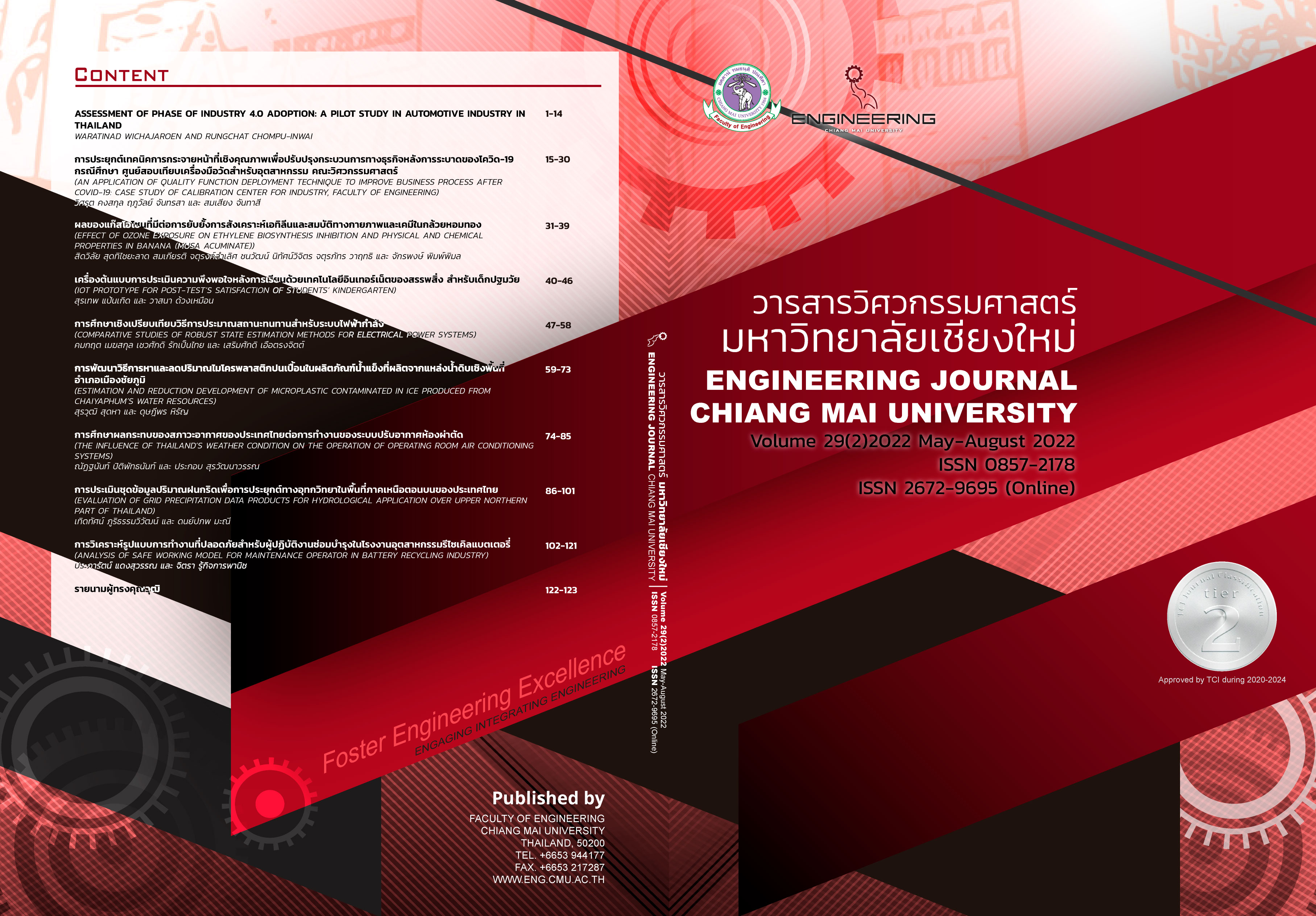The Influence of Thailand’s Weather Condition on The Operation of Operating Room Air Conditioning Systems
Keywords:
safety in operating room, air conditioning, ventilation, humidity controlAbstract
Operating room is a very important room to maintain patient life. The air conditioning system is the main variable that controls temperature, pressure, and relative humidity. If there is a problem with the air conditioning system in the operating room, it may be one of the reasons that the patient has an infection from surgery. Although the percentage may not be very high. but when it happened may cause surgery to fail dismembered patient or die. It may also affect the safety of life of patients, doctors and staff working in the operating room.
In this research, the effects of changes in ambient conditions on the operating conditions of air conditioning systems are studied. Cooling load types were compared in terms of latent heat and sensible heat. The analysis revealed that the Ventilation cooling load was the highest, accounting for 53% of the total cooling load. Conduction in building and Heat load from equipment were the second and third highest cooling load value respectively. The effect of OA results in mixed air (MA) changes in the 68.00 - 69.44 deg F (average value is 68.63 deg F) and results in humidity ratio (W) changes in the 56.28 - 62.08 gr.w/lb.da F (average value is 60.28 %RH). The effect of OA results in supply air (SA) changes in the range of 46.83 – 49.74 deg F (average value is 48.47 deg F) and results in RH changes in the range of 80.67 – 89.98 gr.w/lb.da (average value is 84.65 %RH). From the simulation results all year round for the weather conditions in Thailand, the cooling coil system of the operating room air conditioner must be able to operate under the difference in air humidity across the cooling coil 14.73 – 23.03 gr.w/lb.da. The cooling coil system and the fan system must be able to operate with a coil sensible heat gain ration (Coil SHR) in the range of 0.59 - 0.67 to be able to control the temperature and humidity in the operating room.
References
S. Sadrizadeh et al., “A systematic review of operating room ventilation,” Journal of Building Engineering, vol. 40, Aug., 2021.
M. A. Melhado, “Review of ventilation systems in operating rooms in view of infection control”, in Postgraduate Research Conf. in the Built and Human Environment, Technische Universiteit Delft, BuHu, University of Salford, pp. 478-487.
C. R. Antón et al., “Assessing the Energy Demand Reduction in a Surgical Suite by Optimizing the HVAC Operation During Off-Use Periods,” Applied Sciences, vol. 10, no. 7, Mar., pp. 2233, 2020.
C. A. Balaras, E. Dascalaki, and A. Gaglia, “HVAC and indoor thermal conditions in hospital operating rooms,” Energy and Buildings, vol. 39, no. 4, Apr., pp. 454 - 470, 2007.
“Operating Room Ventilation Systems Best Practices Guide for Energy Efficiency,” in A GREENING HEALTH CARE RESEARCH PROJECT, Nov., 2017.
F. Memarzadeh “Comparison of Operating Room Ventilation Systems in the Protection of the Surgical Site,” ASHRAE Transactions, Jan., 2004.
T. Gormley et al., “Cost-benefit analysis of different air change rates in an operating room environment,” American Journal of Infection Control, vol. 45, no. 12, Dec., pp. 1318–1323, 2017.
K. Khankari “Computational Fluid Dynamics (CFD) Analysis of Hospital Operating Room Ventilation Systems Part I: Analysis of Air Change Rates,” ASHRAE journal, vol. 60, no. 5, May., 2018.
F. Memarzadeh “Comparison of Operating Room Ventilation Systems in the Protection of the Surgical Site,” ASHRAE Transactions, Jan., 2002.
Z. Liu, H. Liu, H. Yin, R. Rong, G. Cao and Q. Deng, “Prevention of surgical site infection under different ventilation systems in operating room environment,” Frontiers of Environmental Science & Engineering, vol. 15, no. 3, pp. 36, 2021.
Downloads
Published
Issue
Section
License
ลิขสิทธิ์ของบทความที่ตีพิมพ์ในวารสารฉบับนี้จะยังเป็นของผู้แต่งและยินยอมให้สิทธิ์เผยแพร่กับทางวารสาร
การเผยแพร่ในระบบวารสารแบบเปิดนี้ บทความจะสามารถนำไปใช้ได้ฟรีในการศึกษา และในทางที่ไม่เกี่ยวกับการค้า




